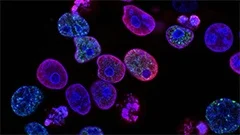Introduction
Cells of the immune system are essential components of the body's defense against foreign invaders, such as bacteria, viruses, and parasites. The immune system plays a crucial role in maintaining health and preventing diseases by recognizing, targeting, and eliminating these pathogens. This comprehensive course will delve into the various types of cells that constitute the immune system, their functions, interactions, and responses to different pathogens.
Overview
- Origin and Development: Understanding the embryonic origins and developmental stages of immune cells.
- Immune Cell Types: Detailed examination of the primary immune cell types: white blood cells (leukocytes), T cells, B cells, dendritic cells, macrophages, natural killer cells, and others.
- Functional Diversity: Exploring the distinct functions of each immune cell type in recognizing and neutralizing pathogens.
- Interactions between Immune Cells: Examining how different immune cell types collaborate to mount an effective immune response.
- Regulation of Immune Response: Discussing the mechanisms that modulate and control the immune system's activity to prevent excessive or inappropriate responses.
- Immune System Disorders: Investigating various diseases and disorders associated with dysfunctional immune systems, such as autoimmune disorders, immunodeficiency diseases, and allergies.
Origin and Development of Immune Cells
Embryonic Origins
- Hematopoietic Stem Cells (HSCs): The primary precursor cells for all immune cell types are hematopoietic stem cells, which reside in specific regions of the bone marrow.
- Multipotent Progenitors (MPPs): MPPs are more committed progenitor cells that give rise to specific lineages of immune cells, such as lymphoid and myeloid progenitors.
Developmental Stages
- Bone Marrow: Immature immune cells undergo differentiation and maturation in the bone marrow before migrating to secondary lymphoid organs.
- Secondary Lymphoid Organs: These include the spleen, lymph nodes, and the lymphatic system, which serve as key sites for the development, maturation, and activation of immune cells.
Immune Cell Types
White Blood Cells (Leukocytes)
- Monocytes/Macrophages: Monocytes are large leukocytes that migrate to sites of infection and differentiate into macrophages, which engulf and destroy pathogens through phagocytosis.
- Neutrophils: Neutrophils are the most abundant type of white blood cell, responsible for rapid defense against bacterial infections by releasing antimicrobial peptides and reactive oxygen species.
- Eosinophils: Eosinophils play a key role in allergic responses, as they produce cytokines and granules containing toxic proteins that help eliminate parasites.
- Basophils: Basophils are less abundant than other leukocytes but contribute to inflammation by releasing histamine and heparin upon activation.
T Cells
- Helper T cells (Th cells): Th cells stimulate other immune cell types, such as B cells and macrophages, to mount an effective immune response against pathogens.
- Cytotoxic T cells (Tc cells): Tc cells directly target and destroy infected or cancerous cells through the release of cytolytic granules containing perforin and granzymes.
B Cells
- B cell Activation: Upon antigen recognition, B cells proliferate and differentiate into antibody-secreting plasma cells that produce large amounts of specific antibodies to neutralize pathogens.
Dendritic Cells
- Antigen Presentation: Dendritic cells are crucial for initiating immune responses by presenting antigens on their surface to T cells, activating them and triggering an adaptive immune response.
Natural Killer (NK) Cells
- NK Cell Activation: NK cells recognize and eliminate infected or cancerous cells without the need for prior sensitization or activation by other immune cells.
Functional Diversity of Immune Cells
- Recognition of Pathogens: The various immune cell types use a combination of receptors to recognize specific pathogen-associated molecular patterns (PAMPs) and damaged self-cells.
- Activation Mechanisms: Upon recognition, immune cells become activated, leading to the production and release of cytokines, chemokines, and other mediators that amplify the immune response.
- Elimination Strategies: Different immune cell types employ distinct strategies for eliminating pathogens, such as phagocytosis, antibody production, and cytotoxicity.
Interactions between Immune Cells
- Cooperation and Coordination: The effective functioning of the immune system relies on the cooperation and coordination between different immune cell types to neutralize pathogens effectively.
- Regulation of Immune Response: Balancing the immune response is crucial for preventing excessive or inappropriate responses, which can lead to tissue damage and autoimmune disorders.
Regulation of Immune Response
Immune Checkpoints
- CTLA-4 and PD-1: These receptors regulate T cell activation by inhibiting the binding between T cells and antigen-presenting cells.
Cytokines and Chemokines
- Regulatory Cytokines: Cytokines and chemokines play a crucial role in regulating immune responses by influencing the recruitment, activation, and differentiation of immune cells.
Immune System Disorders
- Autoimmune Disorders: Autoimmune disorders occur when the immune system mistakenly attacks the body's own tissues and organs. Examples include rheumatoid arthritis, lupus, and multiple sclerosis.
- Immunodeficiency Diseases: Immunodeficiency diseases result from a dysfunctional or absent immune response, making individuals more susceptible to infections. Examples include common variable immunodeficiency (CVID) and severe combined immunodeficiency (SCID).
- Allergies: Allergic responses occur when the immune system overreacts to harmless substances, leading to inflammation and tissue damage. Common allergies include hay fever, food allergies, and atopic dermatitis.
MCQ: Test your knowledge!
Do you think you know everything about this course? Don't fall into the traps, train with MCQs! eBiologie has hundreds of questions to help you master this subject.
These courses might interest you
Create a free account to receive courses, MCQs, and advice to succeed in your studies!
eBiologie offers several eBooks containing MCQ series (5 booklets available free for each subscriber).




